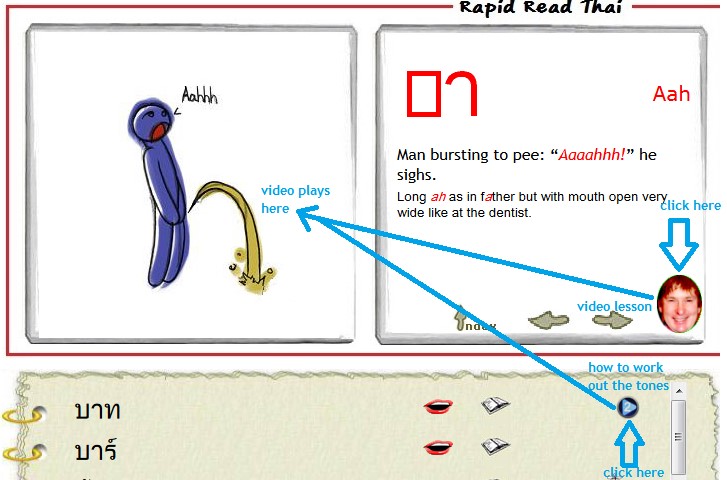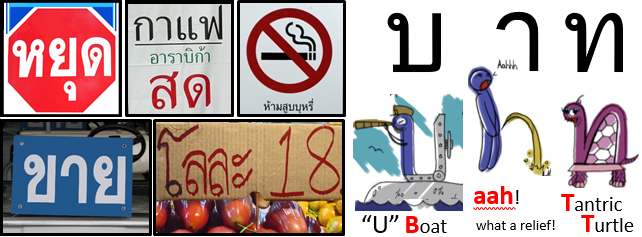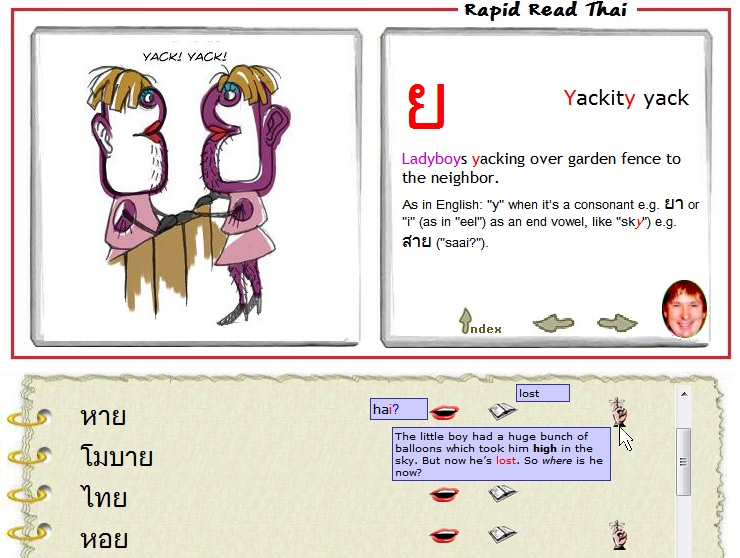The Rapid Method
The ‘Rapid’ approach to learning Thai
Although it sounds incredible, you can learn to read Thai in about 16 hours using the ‘Rapid Method’. Most people take 5-6 months to learn the traditional way, and still struggle to read accurately.
In fact sixteen is the golden number if you follow the ‘Rapid’ approach: 16 hours to become literate and only 160 hours over 16 months to achieve fluency.*
This is because of the minimalistic ‘need to know’ philosophy underpinning the Rapid method: focus on as little amount of material as possible – using Accelerated Learning and other brain-based techniques to internalize and automate the material quickly and easily.
The Rapid strategy is essentially as follows: learn to read, then develop an understanding through reading (and listening to the text being read out aloud), and practice speaking as a physical – not ‘linguistic’ – skill. I call it Face Gym. Don’t bother with writing, it isn’t necessary. (If are academically inclined or wish to produce articles then postpone this as a seperate endevor until after you’ve become fluent in reading and speaking.)
It sounds like marketing hype, doesn’t it? But don’t take my word for it…
This is what participants (real people) have said recently about the ‘Rapid’ course:
“I wanted to thank you for an excellent weekend. I asked my Thai teacher today if she thought it possible that someone with no prior knowledge could learn to read Thai in two days. She said no. When I read some Thai to her she said, “It’s a miracle!!!” This morning I was behind a minibus and was able to read that its route was Krungthep to Baan Beung!!!! I was still smiling when I arrived in Pattaya.” Simon Gunn, Managing Director, Channah Thailand.
“[It] was excellent, I learnt and retained more information [in one day] than I had in the previous 3 months by conventional teaching methods.” Mark Pirie, Triumph Motorcyles.
“I was [astounded] at how I absorbed your material and was able to apply it. […] Well done mate – your depraved teaching methods really work.” Jeff Lafaro, Uhde Shedden.
The ‘Rapid’ Method is based on quirky, bizarre and obscene pictures and stories. So you don’t need to memorize anything. Taking what you already know naturally in English, we apply it to the Thai language. So-called “rising tones” are exactly the same as asking a question in English: “Why?” And we always use the “high tone” when we feel uncertain or skeptical: “Are you OK?” etc.
The ‘Rapid Method’ simplifies the language to only what you need to know, so no learning the Thai alphabet, Ko Kai, Do Dek, etc. You will learn to ‘see’ the shapes and ‘solve the puzzle’ for each word.
 |
The “D” sound “B” sound |
 |
Each letter has a personality based on its ‘sex’, which is either boy, girl or ladyboy! This only matters much later, when you learn how to work out the tones for each word. This bizarre way identifying the letters actually makes tones a doddle.
Try the system out for yourself.
Watch this video and learn 13 letters in ten minutes, download the trial version of the ebook and learn the most common Thai consonants in an hour – instantly and without memorization! – and sign up for the free ‘starter’ version of the Rapid Read Thai course.
I am very busy and, besides, Thai is an obscure language compared with Chinese or Spanish… and I can get by and work or manage my business in Thailand successfully enough without knowing more than a smattering of Thai.
Many people feel this way, and they are right. It’s not essential to know Thai to be able to live and work here comfortably and successfully. Nevertheless, I think it is more useful than you would expect to be able to communicate in Thai if you want to live and work here. I’ve researched the most effective ways of learning a language – with the busy person in mind. I realize that we are all busy with work, family, sports/entertainment and a hectic social life. Devoting time to ‘studying’ is a pretty low priority for most of us (and I include myself).
So my approach is to find ways of learning Thai that requires very little time and effort. I’ve discovered that learning to read is the most important first step. If you attend one of my Read Thai bootcamps then it can be done and dusted in a week.
This then leads on to being able to absorb Thai effortlessly from the environment, the ‘living dictionary’ that surrounds us.
Although it seems counter-intuitive, if you want to be able to speak and communicate then the quickest and most efficient way is through reading… along with listening practice and speech training.
More about this in the follow-on 30-week Everyday Thai for Beginners course and the 50-lesson, one-year Rapid Fluency Course…
*Although being ‘fluent’ can quickly develop into mastering the language at a high level, it does not necessarily mean that you will be capable of advanced and academically correct usage of the language. I define ‘fluency’ to mean being able to read and understand people and communicate effortlessly at normal speed without thinking about it.
Rapid Read Thai Online Course
Learn to read Thai effortlessly with this remarkable self-study e-course.
Thai is a remarkably easy language. It’s only classed as a difficult language because it is usually taught in a very complicated manner.
The reason why Thai is so easy is because it is logical and consistent (unlike English, which is probably the most inconsistent and complicated language in the world). The grammar is as simple as can be (unlike French or German). The writing system is 100% phonetic (unlike English or Chinese): every letter has only one sound.
So what about the tones you might ask? Many words have different meanings if you pronounce them with a different tone – but we have tones in English, and it isn’t always so easy to tell what your meaning is in English if you vary the tone. Right?
Right!
The tones are kinda important in that you need to vary the tone where expected otherwise you the listener will be taken aback and have to ask “come again…?” But in normal (fast), colloquial speech, words are mostly all run together in a kind of monotone and only a few important words – and the ending of a phrase – needs to be sounded out with the correct tone.
In the Rapid Method, we separate out the letters and their sounds from the tones in a two-step process. Learn all the letters first. You can easily learn the Thai alphabet in a day, but that isn’t enough to be able to read Thai. There’s a lot more involved, such as how the vowels are positioned (surrounding the consonant letter, not following each consonant in a left-to-right manner as in English), whether to fuse two letters together (as in “prayer”) or pronounce them separately (as in “pariah”) and how to separate out words when they are written without spaces in-between.
Once you can sound out each word accurately, then you learn how to figure out the tone for each word. You are expected to repeat the course, but this time adding in the tone. After doing this many times, you develop a kind of mental shorthand or dexterity and it becomes automatic and almost immediate.
And – a bit like learning to drive where everything seems so complicated and up in the air at first – it becomes very easy. It turns out that tones are the easiest and least signficiant part of the Thai language!
 Click here to buy (opens in a separate window – please close afterwards)
Click here to buy (opens in a separate window – please close afterwards)
Price: ฿5,750 (£132 / $165 / €155) for the older, more basic version of the interactive online course;
or ฿14,000 (£320 / $395 / €375) for the complete video workshop package.
The price for the older, audio-only version of the course has been increased because I don’t want you to buy it! I’ll continue to support and upgrade it, but it just isn’t as good as the more comprehensive video workshop package. It is still available for you if you really can’t stretch to paying the full amount or if you’re a quick learner who prefers a more DIY approach. You’ll still get some of the bonuses, like the Modern Fonts handout, mnemonics for remembering the Thai Numbers and Names of Letters, and the follow-on mini lessons, but if you subsequently purchase the supplementary material that’s already included in the video workshop package (reading exercises for menus, short stories, songs, etc.) it will end up costing you more.
I strongly recommend that you buy the video package if you can. It consists of far more detailed explanations and nuances; and I guide you through the reading exercises. The cheaper, older version is the same course but with just a brief (audio) explanation of each letter and you will have to figure out how to read each word in the reading exercises yourself.
You can see the difference betweent the two versions for yourself by signing up for the free trial version of the course. The first few lessons in the main section are from the video package and the last two are from the basic version of the course.
Recent  comment: “I have been living in Thailand for just over two years now and I have tried all sorts of methods to learn to speak and read Thai. I’ve tried books, CDs, classes etc, but nothing has helped. By watching your videos I have learned a whole lot more Thai than any of the above mentioned. Thank you for your very helpful and enjoyable videos.” Richard Grant
comment: “I have been living in Thailand for just over two years now and I have tried all sorts of methods to learn to speak and read Thai. I’ve tried books, CDs, classes etc, but nothing has helped. By watching your videos I have learned a whole lot more Thai than any of the above mentioned. Thank you for your very helpful and enjoyable videos.” Richard Grant
|
|
“I really enjoy the way you have structured your lessons, which helps a lot with the learning and recollection. Currently I am getting through about 2-3 lessons a day, maybe slightly more, spending about an hour or two a day. Not because I do not on purpose though, it is so enjoyable! I remember all the basic consonants, vowels and tones now, thanks to your methods. I also try to review lessons that I have already done during the day in between breaks at work, so I am hoping to be able to start with conversation [very soon].” Teresa C
“Congratulations on the fabulous material. All languages should be taught this way. I started on the YouTube videos the night before and was astonished the next morning I had retained all the consonants on those after less than three hours study. This has never happened before with any subject I have studied.” Lhinn Padmottara
“What really impresses me about your online workshop is that not only is it entertaining and fun – but it is also well structured so that you really learn something! A rare combination indeed.” Annette Larke, Australia
“When I was preparing for my trip of a lifetime to Thailand last year I decided to try to learn a little of the language – Then I read that there were over 60 characters to memorize and nearly gave up. Nothing about the characters made them identifiable to me and it looked impossible UNTIL I found your course. exactly what I needed!” Sherry Strain
“Amazing method. And works really well. I never thought learning to read Thai would be easy… and it’s not in most books.” Simon B
“Gary promises miracles when he claims that you can learn to read Thai in as little as two days [Read Thai in a Weekend workshop, 2012]. I know. Madness, right? I took him up on the promise and it is exactly what he delivers. I never expected it to be so fun and easy…” Jacob Heiberg
“Having fallen in love with Thailand years ago, I became determined to learn the language in order to understand the culture and develop friendships. Of course it became a fairly difficult task to say the least. Then I heard that the people who become really fluent do so by learning to read the language. That turned out to be even more difficult than pronouncing the tones! Through a stroke of good luck I became aware of Gary Orman’s work in teaching a rapid way of learning to read Thai. I immediately signed up for the course and this turned out to be a huge game changer for me! To my complete surprise, in a very effortless way, I was able to read the language! This has had a very profound effect on how I am able to pick up the language and pronounce the tones. Gary really has a passion for teaching people to read and I was very impressed with the level of service he offered. I am indeed extremely grateful that I stumbled across this program!” – Terry Johnston, Canada.
 If you’re not ready to buy yet then please sign up for the free trial version of the course. You can complete the basic part of the course for free where you will learn to recognize about 30 letters and read and understand your first 100 easy Thai words – all in about three hours! Try out the foundational lessons of the Video Workshop series also for free.
If you’re not ready to buy yet then please sign up for the free trial version of the course. You can complete the basic part of the course for free where you will learn to recognize about 30 letters and read and understand your first 100 easy Thai words – all in about three hours! Try out the foundational lessons of the Video Workshop series also for free.
More about the course
As you practice your reading skills (simply by being out and about in Thailand), you will subconsciously acquire a comprehensive ‘real Thai’ vocabulary. It’s a great way to begin learning the Thai language.
Price: ฿5,750 (£132 / $165 / €155) for the older, more basic version of the interactive online course;
or ฿14,000 (£320 / $395 / €375) for the complete video workshop package.
 If you’re not ready to buy yet then please sign up for the free trial version of the course. You can complete the basic part of the course for free where you will learn to recognize about 30 letters and read and understand your first 100 easy Thai words – all in about three hours!
If you’re not ready to buy yet then please sign up for the free trial version of the course. You can complete the basic part of the course for free where you will learn to recognize about 30 letters and read and understand your first 100 easy Thai words – all in about three hours!
You can upgrade to the video workshop package from the regular audio-only version of the course at any time – just pay the difference of 6,450 baht. Please contact me when you are ready to do so and I’ll send you the payment link. You can also change your mind (within 30 days) and downgrade to the more basic audio-only version of the course if you prefer and I will refund you the difference.
TECHNICAL NOTES. The latest version will work on any browser except Opera. You will also be able to save the courses to follow offline. If you have an iPad then please buy Offline Pages ($5). If you have Windows then please buy Offline Explorer ($60). For Mac, you could try SiteSucker, Maria(free) or Web Devil. And for Android devices, Offline Browser looks good.
To pay by credit/debit card, choose PayPal (you don’t have to join PayPal!). I also accept direct transfers to a Thai bank (baht) or a UK bank (pounds), in which case choose Manual Payment/ATM/Bank Transfer for instructions on how to pay.
Speak everyday conversational Thai
in only 7 months of minimal and effortless study
|
This remarkable program was developed and refined by Wiworn Kesavatana-Dohrs (or P. Som! for short) over the last 30 years as a first year university course in Thai Language at the University of Washington. The “Rapid” version of the course is an interactive, expanded course based on the book Everyday Thai for Beginners (currently available from Amazon or Asia Books for around ฿800).. After you’ve learnt to read with the Rapid Method, it will then only take you seven months to complete a one-year university program. What is remarkable about this program is that we’ve incorporated all the minimalist accelerated learning principles of the Rapid Method so that you can become fluent in basic everyday Thai with hardly any time or effort – no more than around 20 minutes of self-study every day and two 1-hour sessions per week with your Thai teacher. (The university course is one hour every day, plus several hours of homework study each week…) With the Rapid Read Thai course, you already have an amazingly solid foundation that allows you to continuously pick up additional vocabulary from your surroundings and to develop good diction that makes it much easier to communicate from day one. The follow-on Everyday Thai for Beginners course focuses on conversational phrases and speaking drills. You need to engage a private Thai teacher who will follow the Rapid Method strategy. We can recommend a Thai teacher for you (only ฿300 per hour) who will usually work with you online using Skype, or I can instruct your own teacher in the “Rapid” stragedy to follow. You need someone who knows enough English to be able to interpret (as opposed to translate) meanings between English and Thai, and explain how to communicate within the context of Thai culture – and of course someone who can check your pronunciation and chat with you in Thai, so that you start to develop your ear for the Thai language. The Everyday Thai for Beginners online course costs ฿7,000 ($200/£160/€185) and you should budget an additional ฿18,000 ($510/£410/€475) for the sixty 1-hour lessons with your private Thai teacher (at ฿300/hour). Please add 5% if you wish to pay your teacher by credit/debit card or PayPal. |
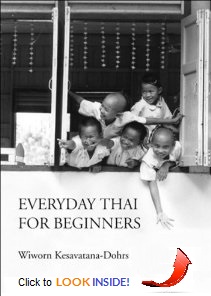 You may need to register or log in first to LOOK INSIDE |
 Click here to order the Everyday Thai for Beginners package
Click here to order the Everyday Thai for Beginners package
The Everyday Thai for Beginners course consists of the same material as the book but redesigned to incorporate the “Rapid” method of learning. The ebook is interactive, with embedded audio, so that you can listen to the vocabulary and the sentence patterns immediately. The idea is to progress quickly and effectively through self-study. However, I strongly recommend that you work with a Thai tutor, first to understand each chapter and get your pronunciation just right, and second to practice speaking using the vocabulary and sentence patterns you have been studying.
Anki spaced-repetition flashcard files
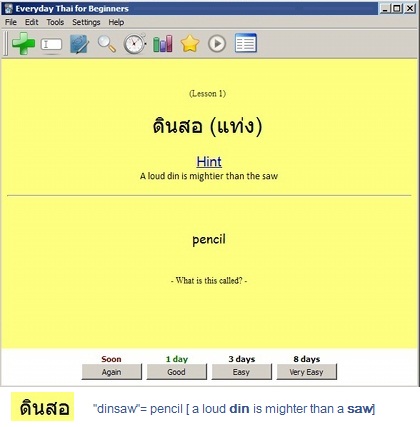
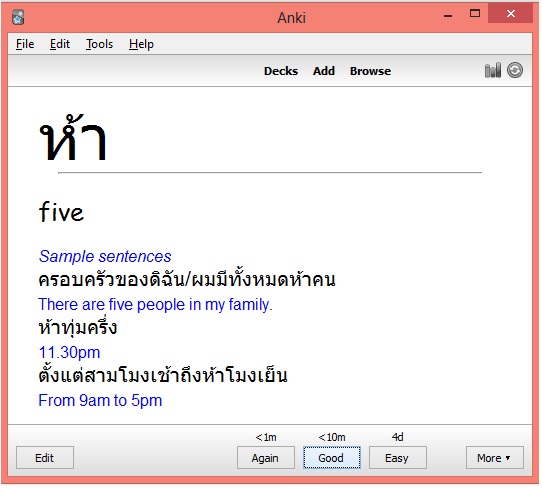
The package includes a set of 1100 flashcards using the “Anki” spaced-repetition memorization system that has been especially adapted to include mnemonic hints to help you memorize each word and example sentenes (with audio) for each word. There’s no point in learning how to speak unless you acquire a basic speaking vocabulary. Anki will help you do that with minimal effort.
With the top 1100 words memorized, and a little practise speaking and listening to typical sentence patterns, you can communicate competently in virtually any everyday situation.
The interactive clickable audio-book version (with printable PDFs for use with your teacher) and the 1100-word Anki flashcard file is available now
Download Anki for free directly from the Anki website. (Anki costs $25 for iPad or iPhone. Download from the Apple App Store. It’s free for all other computers and devices. You need the free desktop version to be able to manage your cards and synchronize with your mobile device.)
 Click here to order the Everyday Thai for Beginners package
Click here to order the Everyday Thai for Beginners package
Note: there is no transliteration. The Thai words are only in Thai script, so you need to know how to read before this course will be of any use to you.
Technical note: the ebook is a browser-readable system consisting of MP3 audio files and javascript. It can be followed on any modern computer or device with any browser that supports MP3. You can also download the ebook for offline reading.
INSTRUCTIONS
Building up your vocabulary is an important aspect of the ‘Rapid’ approach. Words are your basic building blocks for expressing yourself and understanding others. You need them. The more you know the better, but it’s important to learn the useful ones, the ones used by people in regular conversation, and that you’ll come across in notices, street signs, menus and the internet. Everyday Thai includes most of the important words you need to know. Whatever anybody says about learning only 100 words, or 300 words, you can’t really have even a basic conversation without at least 1,000 words. When you aim for ‘fluency’ in the next phase, you should learn at least 3,000 words.If you choose to work with a Rapid-certified teacher, this will be your schedule: Work through one lesson on your own (50 minutes on day one) just to familiarize yourself with the words and basic concepts. Then work through the vocabulary for that lesson using Anki (10 minutes on day one and two) followed by an hour on day two with the Thai teacher who should explain what’s going on grammatically, help you with your pronunciation and practice some simple conversations with you. You should spend the rest of the week doing 10 minutes a day of Anki.
Speech Training. This is crucial yet often overlooked aspect of learning a language – perhaps because it’s just muscle training rather than a linguistic exercise. Take a few sentences and repeat them over and over again in a loud and exaggerated way (don’t be shy!) until you can say them quickly and accurately without thinking. The idea is to develop strength and fine motor control so that you mouth and tongue operate automatically. Do it for one sentence until you can do it pat – like a tongue twister. Later, you can vary the pattern slightly: Can I have a cup of tea, Can I have a glass of milk, Can I have a bottle of beer, etc.… Do this 10 minutes a day, while walking, driving, showering… An excellent resource for this is Instant Thai.
It helps to spend another hour with your Thai teacher around day 5, but this time just have fun. The Rapid teacher guides the conversation carefully using only the vocabulary and concepts that you’ve learnt up till that point. She also diagnoses and corrects your pronunciation, using the ‘speech training’ method.
The following week, you then move on to the next lesson. There are 30 lessons, so that means seven months, but only spending 2 hours ‘studying’ (plus 1 hour doing vocab and an hour or two with speech training and conversation) per week. You get to experience several hours of language learning without realizing it, especially as you can slip a lot of into your day, while travelling or waiting or just as part of having a coffee/tea break. You’ll be surprised how much you’ll be able to say and understand in a few months, with so little effort.
After completing the Everyday course, you can follow my ‘fluency’ course, which is based on a novel called Sydney Remember. The writing style is straight forward, with lots of typical conversation and slang. I’ve digitised the book and produced an audiobook version to practice listening and speaking. After completing this book, you should be relatively fluent in being able to speak and understand Thai. It takes a year to work leisurely through the book, around 10 minutes a day.
Unless you have a lot of free time on your hands and enjoy spending hours studying every day, there is no need to rush. I’ve designed my system specifically for people who lead busy lifestyles. I also don’t have more than about 10 minutes a day to learn Thai. It’s better to do 10 minutes every day over several years – getting gradually more and more expert in the language – than to try to cram it all in over a few months (and get nowhere, and then give up).
Fluent Thai
The most effective way to gain fluency* in Thai is to read aloud and listen to modern, colloquial texts.
CHILDREN’S STORIES
Children’s stories are not easy! The language used is often a little obscure and “literary”. Many are irrelevant for everyday conversation, often about witches, animals or monsters. Even those that are about everyday family life are not particularly relevant to adults traveling or living as an expat. Fables are useless, avoid them.
SYDNEY REMEMBER
If you want to be fluent in conversational Thai then this is the course for you. The introductory Everyday Thai for Beginners course is sufficient for interacting with Thai people about basic, everyday matters (shopping, ordering food, money, saying hello and asking about interests, friends and family). But now you want to have a relatively fluent conversation with Thai friends and colleagues about their personal lives and activities and their thoughts and feelings. A romance novel is most appropriate because it will usually include all the elements of relating to people on an intimate level.
Sydney Remember was selected for this reason, plus the fact that it’s written in an easy, straight-forward and colloquial style, with plenty of modern (and useful) slang. It’s also a fun story about a Thai girl from Bangkok who goes to live with her cousin in Sydney, has to deal with visa issues, finds a place to stay, finds word, learns English and makes friends with various characters that she meets.
It’s a one-year course, working through each lesson in a relaxed fashion, two one-hour sessions per week with a Thai tutor, a little reading and listening plus an additional 10 minutes everyday building up your vocabulary using Anki.
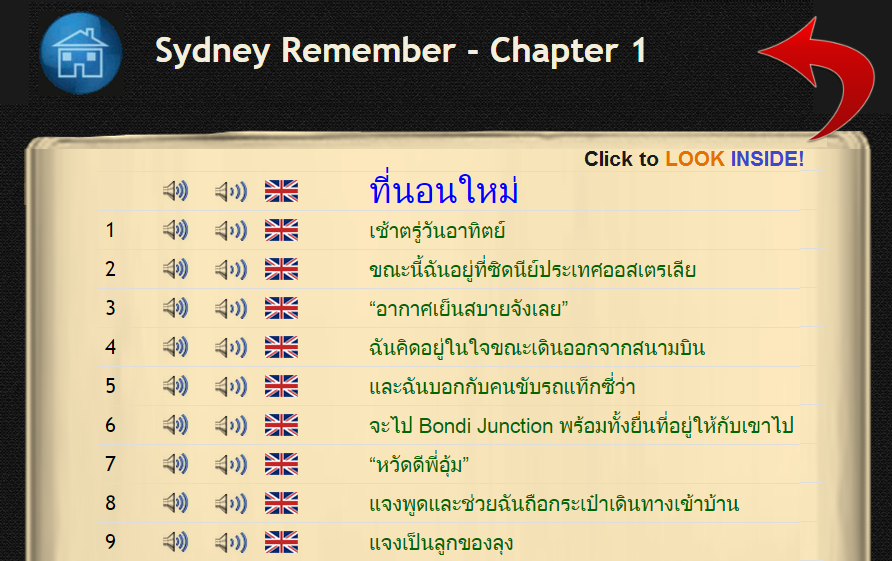
Note: you may need to register or login first to LOOK INSIDE.
The interactive audiobook course is designed to be read aloud and listened to one sentence at a time, over and over again, until you can hear and understand each word clearly. There’s even a slow-play button! View the hidden English translation by clicking on the icon.
 Click here to order the Sydney Remember Fluency package (7,000 baht)
Click here to order the Sydney Remember Fluency package (7,000 baht)
Anki spaced-repetition flash cards

It comes with the 3,000-word Anki flash cards to build up your vocabulary, as well as a convenient karaoke-style audiobook (for iPad/iPhone or Android devices) that allows you to listen to the story being read out to you at variable speeds and repeated several times so that you “get it” crystal clear. It’s the best form of language ear training there is.
TOP STORY
Once you’ve finished the novel, you are ready to learn “business” or “commercial” Thai.
“Top” is a young teenager who didn’t enjoy studying, but loved to play computer games. He hit on the idea of selling virtual weapons and made a cool fortune while still at school… until his account was shut down for “unauthorized activity”. Then he tried his hand at various other business ideas, failing at most of them, but eventually became successful by selling roast chestnuts at various shopping malls.
Until that activity was curtailed.
So he struggled on, looking for other ideas. He eventually hit on the idea of selling fried seaweed, but he almost couldn’t figure out a way to sell it commercially. After a string of bad luck and bad judement, he almost didn’t get the lucky break with 7-11 to supply all of their stores with his product. He needed a factory, but although the banks would have lent him the money based on his busines plan and purchase order, they couldn’t do so because he was still only 19 years old.
It’s an intriguing and inspiring story of how “Top” perservered against all odds until he eventually became a “Baht Billionaire”, at the tender age of 23.
The language is colloquial because the biography Top Story is based on interviews with “Top”, but as the subject matter is about commerce and finance and marketing and production, you will learn how to discuss business in Thai.
– more details and trial courses to follow –
* By “fluency”, I mean being able to speak without having to think about it. It does not mean academic correctness and you will not necessarily do well in a language test, nor be able to converse in an academic, university setting.
Understanding spoken Thai isn’t easy and it’s the culmination of reading, vocabulary-building and ear-training. That’s why these fluency courses are designed to be listened to, over and over again, at slow and normal speeds, until you can pick out every word clearly.
Testimonials
I realize that it sounds all too incredible to be true. Some people believe it’s a scam or a marketing gimmick of some kind. That’s understandable considering that we are bombarded with dishonest or misleading messages all the time.
To understand exactly what you can (or can’t) achieve with the ‘Rapid’ method, please also read this article.
FEEDBACK FROM ACTUAL WORKSHOP PARTICIPANTS
So rather than take my word for it, read what other people, who actually attended my workshops or followed the self-study course have said:
I can’t keep up with all the testimonials, but I’ll post more as soon as I can. In the meantime, watch some of the video interviews of the workshop participants on my Youtube Channel
THE GOOD
Gary, what a great day. Thank you so much. I was on the way home on the BTS reading the signs everywhere… What an experience… Your course is fantastic! Stephen Reynolds, Stephen Seminar
![]()
It was like taking down the shutters from the windows and being able to see out for the first time. Colette Baily
![]()
I wanted to thank you for an excellent weekend. I asked my Thai teacher today if she thought it possible that someone with no prior knowledge could learn to read Thai in two days. She said no. When I read some Thai to her she said, “It’s a miracle!!” This morning I was behind a minibus and was able to read that its route was Krungthep to Baan Beung!! I was still smiling when I arrived in Pattaya, so many thanks for the opportunity. Simon Gunn, Managing Director, Hannah Thailand
![]()
This course was fantastic – exactly what I needed in my quest to learn to read Thai. I must admit I was a little skeptical at first, but the course exceeded my expectations by miles. We were really reading Thai script by the end of the week and I am continuing to learn more every day with the online resources and follow on suggestions from the instructor. I’ve tried other methods of learning the Thai alphabet but Gary’s pictures are just what I needed to help me remember. I highly recommend this course. Cheron Gelber, Seattle
![]()
I’ve just finished the four half-day course learning the Thai script almost effortlessly and now I can read Thai. I am not often sure what the word means but I can read it in Thai. The course is based on associating each letter with a drawn character, sometimes funny, sometimes rude and always memorable. After a couple of lessons you can read some of the signs in the street and by the end of the course you are fluent in the Thai alphabet. This painless way of mastering the alphabet gives a sense of achievement and learning the language itself becomes less daunting, more interesting and great fun. Paul Sullivan, author, Chiang Mai
![]()
Thanks again for the class – so much fun to be able to break through the illiteracy barrier :). I’m sounding things out and enjoying discovering some words that I already know. I’m going to keep practicing recognizing the modern fonts – your sheet, listing the [font equivalents] is helpful! Your class has given me a great base to work from. Cheri Boyd
![]()
I was amazed at how I managed to absorb your material and able to apply it. And now with some help from my Thai colleagues, who play word games with me, I am really reinforcing my reading and writing. Well done mate – your depraved teaching methods really work! Jeff Lefaro, Uhdeshedden
![]()
I’m 60 and the smarter 20-year olds in my spoken Thai course are in awe of how I’ve jumped ahead of them. I now know the entire Thai alphabet and it happened so quickly in the Read Thai Workshop, I almost feel I cheated. But I can read Thai signs in real life, by golly, and the person I’m most impressing is me! [As for the reading exercises] using Sydney Remember, that would work great for me and would be great for confidence-building… your workshop’s already a cool confidence-builder. Chris Hacker, Mascom
![]()
I had a great time in the workshop which is amazingly effective. I [am looking forward to your follow-on] course! Ian Chapman, Mayer Brown JSM
![]()
I’ve been reading a lot of the signs in the street though, my girlfriend was impressed 😉 I’ve recommended your course to some of my friends, I think it is very good for people who speak a bit of Thai already. I believe for pure beginners it’s not so fun when you don’t understand a single word of what you read.* Damien Kerneis, Geodis Wilson
* Since this response, the course was modified to make it much more accessible for complete beginners…
![]()
Thanks again for a great day. You made it fun and interesting. I have been driving very poorly since Saturday, I keep slowing down to try and read the signs!!
I managed to read “Tesco Bangna” while at lunch the other day and I cheered out loud 😀 This is fun and I have started doing the reading exercises, [as a daily routine] with a cup of fresh coffee!! The biggest challenge at the moment is finding where one syllable ends and the other begins, but I am sure with practice that will get better. I will continue to recommend your course to others. Linda Belonje, KIS International School
![]()
I enjoyed learning how you teach your method and benefited from the tone portion most of all. You are a very enthusiastic teacher and I think that this will go a long way in helping all of your students to see reading Thai as both doable and fun. I’ll be sure to mention your program to people I work with who want to learn how to read Thai. Thank you for all of the resources, lunch, lovely walk through the gardens and, most of all, for your generosity, enthusiasm and creativity. Lauren Vitrano-Wilson
![]()
I know Gary – I’ve heard that he personally put in a lot of $$ and effort in putting the product together. Gary is a very creative guy – I think he may hold the De Bono license for Six Hats here. I looked over the original material – there were a few linguistic glitches there in the version that I saw, but on the whole, the concept works.
When teaching Thai, I’m a strong advocate to get people into reading the Thai script and understanding how it relates to the tone rules as soon as possible. For many, this seems to be a huge obstacle. Hopefully Gary’s programme can help a lot of people get over that speed hump.
As for the cost – if it works, I think it’s worth it. I’ve seen people spend a lot more over years and still struggle with it.
Stuart Raj, Mnidcraft [sic] – watch Stu’s youtube video for TV interview about learning Thai
![]()
First of all, I really enjoyed the weekend. Of course, there were moments of frustration when I couldn’t remember, and I’m still having some trouble with the odd vowel combinations. It was hard work, but you added some elements of fun, too.
I’m beginning to recognize some of the modern fonts. I’ve had great fun reading signs, and trying to tackle product labels, etc. I’m also able to see signs I never noticed before and actually read them!
Because I was able to work with the ebook prior to the workshop, I was pretty well versed in the basic consonants and the basic words that went with them. Repeating them in the workshop was good reinforcement, but the later material hasn’t sunk in too well yet.
This made the stories a bit too complicated for me, but good learning just the same. I think Winnie the Pooh was a good choice. I would have enjoyed something also in the form of a basic dialogue. I don’t think word-for-word translations are all that helpful… the idiomatic stuff is important.
[…]The hotel conference room setting was good, and lunches were excellent. On the reading exercises, it might be helpful to separate the words (even though Thai doesn’t ordinarily do that) to facilitate word/syllable recognition. And perhaps some specific attention to some of the odd combinations (vowels and consonants both).
Your picture illustrations, as silly as they might be, have really helped to embed in my mind most of the letters and their sounds.
Steve Shields
![]()
I have been practicing on signs and with my personal trainer, who likes to put a word under my face when I do push-ups. The Thais laugh at the muttered “dead thin ladyboy thin, meditating”, etc. but are excited when I read the words. Now I just need more vocabulary.
Suggestions for the course:
- Do less words for each letter on the exercises. Pick 5 to do as students can practice later online. That way you could get to more letters. […]
- Do not put as many exceptions or weird ones in when students practice. Perhaps group more of them as exceptions and talk about them specifically [later]. I would have preferred more everyday Thai words.
- I thought the stories were a bit hard and found it a bit frustrating to keep flipping my paper over to see the vocab words. However other people did not seem to have the problem. I am not sure if you could find a simple story with common words most new beginner Thai speakers would know.I would do one short story and then the newspaper article.
- I think some of the rules were a bit rushed at the end, dating consonants and double rolling ladyboys for example. I feel cutting back on the words would give you more time to make sure all this is covered. [I’ve since modified the workshop content in response to these excellent suggestions…]
Just wanted to say thank you again for your patience in answering my questions. I think I have a better grasp of singing and dead sounds. And I seem to be getting my tones right. I just need to get my PT guy to print like he is in primary school. 🙂
The download is good, but I preferred the class. Next to paying my tax preparer, this has been the best money I spent this year!
Joelle Crouch
![]()
I enjoyed your workshop very much and felt that I got a lot out of it. I spent a few hours on the Friday before the class going through the materials, which I think was pretty essential to getting full benefit from the class. On the whole I tended to focus more on the “reading” and much less on the meaning of the words, but there are limitations in learning so much in a short amount of time, so I will need to focus on that later.
The length of the word lists was about right for me. You mentioned in one of your materials that learning to read Thai is like solving a puzzle. I enjoyed that aspect of it. The story translations were an important part of the process because it introduces the task of picking through words that are strung together. The stories were a bit long, however. Maybe spicier stories would help. It’s a bit of a let-down to go from depraved ladyboy stories to Winnie the Pooh. I did however learn that Pooh is rather dumb; I never knew!
I like the format and consecutive days. Your presentation and classroom skills are great, and you have a good personality for it. In addition to the quality of your material, I think your personal qualities are also a big part of the reason people enjoy your workshop. Needless to say I will recommend your workshop highly. David Washenfelder
![]()
I love your course. It’s great. My first wing at [learning Thai] I was very frustrated now 6 months later very easy. I only had the old course the first time, the new one is very easy. I like the video course very much. Your course has really helped with understanding and pronouncing the few phrases that I learned with my tutor.
I did about 400 hours so far of the ALG at AUA. The method of teaching reading and writing at AUA is old school way so I thought about you right away when I thought about reading and writing. I never really paid attention in class as they say it’s all automatic. All they guarantee is the understanding and speaking of a two-year-old after 800 hours. But if i think back I didn’t know much at 2 years old! Ryan Herter
![]()
THE BAD
I agree that reading is very important. But so are the other skills – listening, speaking and writing. Most people’s ultimate goal is conversation. And while I agree that all the skills reinforce each other, reading reinforces conversation for example, I think saying that the best way to learn is reading undervalues the other skills.
I feel that you are making promises you can’t keep, like so many others trying to sell their products.
“Speaking is actually not really a ‘language’ skill” Totally disagree. The four basic skills are reading, writing, listening and speaking. You can make up your own definitions, but this one is widely accepted.
Your going around telling everybody speech isn’t a skill makes you sound uninformed, and annoys those of us who are somewhat familiar with the linguistic terms.
How do you define fluency? It is deceptive to try to convince people that learning a language is easy.
I would be impressed if you can take raw beginners and teach them all the characters and all the rules in such a way that they will actually stick by the end of 16 hours. This would necessarily involve the reading of simple words and sentences. But you go beyond the claim of simple sentences, and say they can read native material (a newspaper for example) with correct pronunciation by the end of your class. This is impossible… Would you like to change your claim? … Don’t tell people they’ll be able to read native material with correct pronunciation after 16 hours if in reality they’ll only be able to read simplified texts.*
R Flaherty (in response to my review of Everyday Thai for Beginners)
* Yes, you will be able to read native material, even newspapers – except you will probably not understand what you are reading if you try to run before you can walk… and the very stylized fonts in newspapers might confuse you. Nevertheless, we do also cover how to read modern fonts in the course.
![]()
Forum comment in response to my postings about the Rapid Method:
[This is] classic self-made internet guru behaviour.
- Develop amorphous “enemy” to attack with vague undefined references. “the Thai way”, the “widely accepted approach”, etc.
- Attribute end-point failure to speak fluently and/or accurately to these buzzwords, rather than the quality of teaching…
- When someone comes along who knows you’re misrepresenting what’s already there, or that you’re abusing standard terminology, you simply attack them as being brainwashed by orthodox methods. This line makes your opinions impervious to all attack from anyone with half a clue, and the internet guru preys on the uninformed and easily led.
- If you want the easily led to believe in your authority, you’re going to need to quote “research”, but not explicitly. You’ll say a vague statement and mention Krashen, and say something more specific and mention your own research, which isn’t usually anything accepted as academic research…
- And if all else fails, put on those puppy dog eyes and say “why are you being so mean to me? I’m only trying to help people. All you people ever do is criticise, at least I’m actually doing something.” Nìall Beag, Lingua Frankly
![]()
It is amazing that anybody can take a person seriously who claims that you can learn to read Thai in 16 hours.
I haven’t dealt with Thai yet, but even though its alphabet may be more complicated than the Greek or Cyrillic ones I do think that it is worth learning and using the alphabet of any language from the beginning. A romanization is only relevant if it represents a fairly precise rendering of the phonemes of the language, and then only as a supplement to reading stuff written in the original alphabet of the language. Iversen, De Berejstes Klub
![]()
THE UGLY
Avoid Gary Orman’s rubbish like the plague, the guy is just a con-artist and a rip-off artist. The other guy who is backing him up [Stuart Raj], is quite obviously in league with him. I purchased the ebook, and it’s a complete rip-off of “60 Minutes to Learn the Thai Alphabet book. “therealthing”
This rather scathing attack needs a comprehensive response:
Firstly, “therealthing” didn’t buy the ebook (and if he did and didn’t like it, he would have been refunded). Secondly, the 60-minutes idea was arrived at independently. I had already developed my ideas several years before, having produced an online course to learn basic Hebrew in 40 hours (in 1997). Besides, Rudolf Steiner beat both of us to the post by inventing this technique 100 years ago. Not to mention that the Chinese and Japanese have used similar approaches to teaching children to read for centuries. I was hoping to collaborate with Damian (author of 60 Minutes), but he said he only spent six months in Thailand and was busy with another project. 60 Minutes is, in my opinion, on the right track – but there are a few fundamental mistakes (e.g. there are no initial and final sounds for a letter, just one sound; and there’s also no “g” or “j” sound in Thai); and the course only covers the individual letters – completely omitting the tone system, as well as how to recognize, read and correctly pronounce whole words.
As for Stuart Raj, the man who is fluent in over a dozen languages, we were hoping to collaborate on this project in the early days (in fact, ‘aaaahh’, the ‘bread’ and ‘two breads are bad’ are his ideas!) We are not assiciated with each other in any professional capacity. In fact he is a competitor, with his own series of courses, including Cracking Thai Fundamentals and Mnidcraft (not a typo)…



